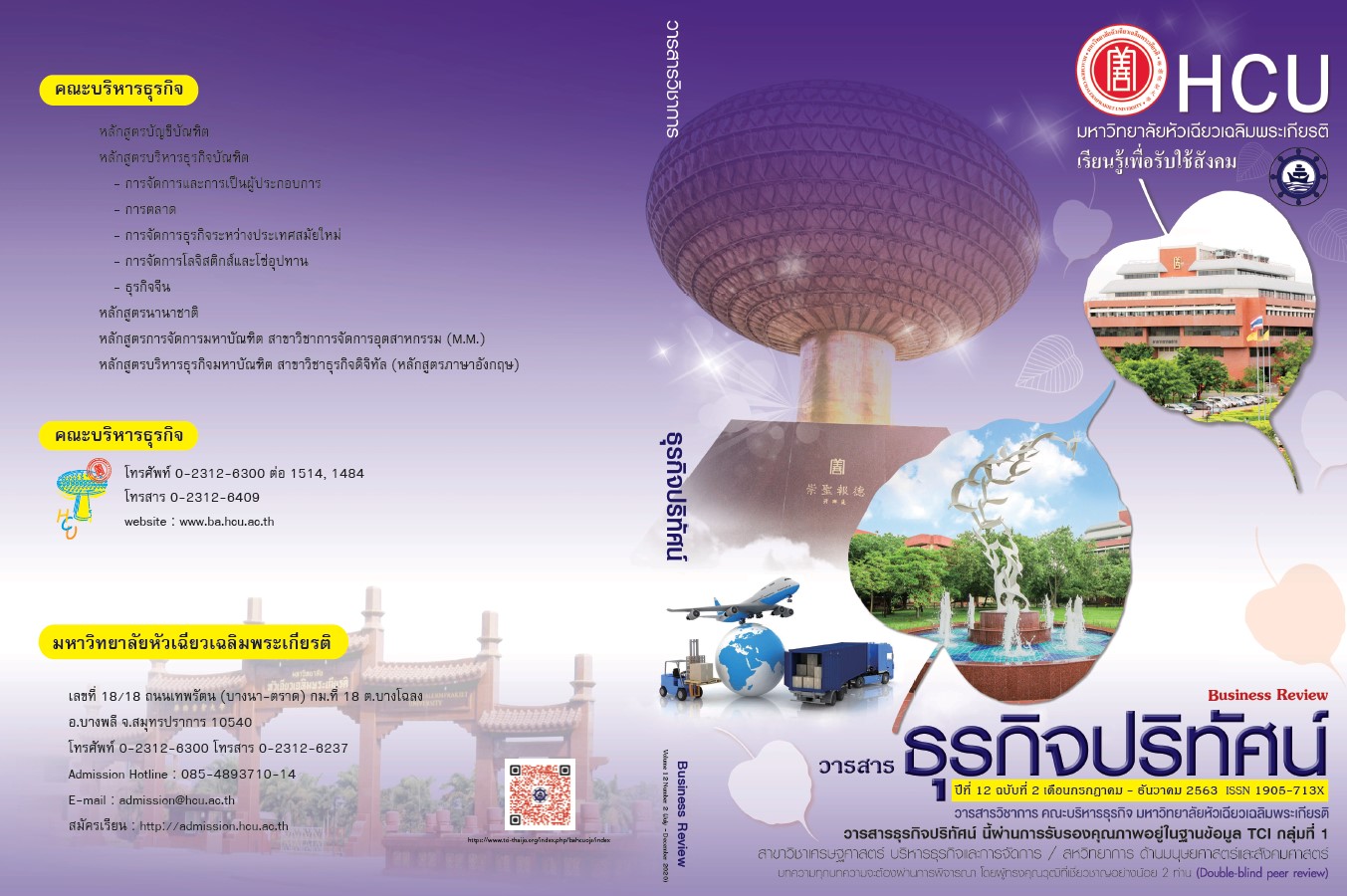The Marketing Distribution Channels Development for Snake-Skined Gourami Through the Community Enterprise Networks Within Thailand Market
Keywords:
Development of distribution channels, community enterprise network, Snakeskin gouramiAbstract
The objective of this research is to study the current administration relative to the Conservation of the Bang Bo snake-skin gourami and processing community enterprise, Khlong Dan Sub-district, Bangbo District, Samutprakan Province, in order to pave the way of developing an enterprise management system as well as proposing possible distribution channels through community enterprise networks in different areas of Thailand. This research uses qualitative research methods. The main informants are 8 members of Bangbo Snakeskin Fish Processing Community Enterprise. The data collection techniques for this research include in-depth interview, participatory observation and focus group. For the quality of the research, the triangular method is applied in order to check the data. The results show that although there are a number of farmers raising and processing Bang Bo fish, it is reduced to just over 30 people this year. Group members of this research are in the production chain of snakeskin gourami both upstream, midstream and downstream. This plays an important role in driving large plots of snakeskin fish farmers with emphasis on raising and processing according to traditional conservation practices passed on from the generation to generation in the Khlong Dan Subdistrict, Bang Bo District. The Group focuses on using natural ingredients as the main ingredient and selling products at fair prices to manufacturers and consumers. However, the problem is that the lack of funds for operations causes obstacles for group development. For the distribution channels of the Conservation of Bangbo snake-skin gourami and processing community enterprise group, it is possible to distribute across three networks namely, Community Enterprise Networks in other areas, Thailand Post Company Limited and Huachiew Chalermprakiet University.
References
กษมาพร พวงประยงค์ และ นพพร จันทรนำชู. (2556). แนวทางการพัฒนาวิสาหกิจชุมชนกลุ่มการแปรรูปและผลิตภัณฑ์ จังหวัดสมุทรสงคราม. วารสารศิลปากรศึกษาศาสตร์วิจัย, 5(1), 108-120.
กรกมล ซุ้นสุวรรณ ธัชตะวัน ชนะกูล ณัฐพล ทุ่งเย็น จุฑามณี มีโชค และวรางคณา เอ็มเล่ง. (2560). การพัฒนาระบบพาณิชย์อิเล็กทรอนิกส์สำหรับจัดการผลิตภัณฑ์วิสาหกิจชุมชนกลุ่ม แม่บ้านควนน้ำใส จังหวัดสตูล. การประชุมหาดใหญ่วิชาการระดับชาติและนานาชาติ ครั้งที่ 8, 22 มิถุนายน 2560 มหาวิทยาลัยหาดใหญ่.
กิตติชัย ปรีน้อย. (2560). กลยุทธ์ Re-Targeting กับการตัดสินใจซื้อสินค้าของธุรกิจ SMEs ประเภทวัสดุอุปกรณ์ และวัตถุดิบ ที่ใช้สำหรับการผลิตและแปรรูป (B2B). วิทยานิพนธ์ปริญญามหาบัณฑิต, มหาวิทยาลัยกรุงเทพ.
กังสดาล กนกหงส์. (2561). แนวทางการพัฒนาและการจัดการเครือข่ายของกลุ่มวิสาหกิจชุมชนพืชผักอินทรีย์ จังหวัดเชียงใหม่. วารสารการพัฒนาชุมชนและคุณภาพชีวิต, 6(2), 261-270.
โกสินทร์ ชำนาญพล และ สุดาใจ โล่วนิชชัย. (2562). การพัฒนารูปแบบเทคโนโลยีดิจิทัลเพื่อส่งเสริมศักยภาพผู้ประกอบการ. วารสารราชพฤกษ์, 17(2), 130-138.
ชญานิศ จิตรีปลื้ม. (2558). กลยุทธ์การทำรีมาร์เก็ตติ้งผ่าน Google Display Network กับประสิทธิ ภาพของการ โฆษณาสำหรับธุรกิจ B2B ประเภทโรงงานผลิตเครื่องสำอาง. วิทยานิพนธ์ปริญญามหาบัณฑิต, มหาวิทยาลัย กรุงเทพ.
ชนพงษ์ อภรณ์พิศาล. (2560). ปัจจัยที่มีผลต่อประสิทธิผลการบริหารจัดการวิสาหกิจชุมชนในภาคกลางของไทย. ดุษฎีนิพนธ์หลักสูตรปรัชญาดุษฎีบัณฑิต สาขาการจัดการ, มหาวิทยาลัยสยาม.
เชิดชัย ธุระแพง. (2551). รายงานวิจัยการพัฒนารูปแบบเครือข่ายวิสาหกิจชุมชนเพื่อเพิ่มช่องทางการจัดจำหน่ายสินค้าในการดำเนินการของโครงการตามพระราชประสงค์ดอนขุนห้วย จังหวัดเพชรบุรี. สำนักการจัดการศึกษาภายนอก มหาวิทยาลัยราชภัฏเพชรบุรี, 2551
ธารทิพย์ ธรรมสอนและคณะ. (2549). การวิจัยเชิงปฏิบัติการแบบมีส่วนร่วมเพื่อพัฒนาเครือข่ายวิสหกิจชุมชนกลุ่มแม่บ้านผู้ผลิตกรณีศึกษา : ผลิตภัณฑ์ประเภทอาหาร จังหวัดกำแพงเพชร. สักทอง.วารสารมนุษยศาสตร์และสังคมศาสตร์, 12(2), 71-80.
นุรนัจมาร์ แวโด. (2557). ปัจจัยแห่งความสำเร็จของกลุ่มวิสาหกิจชุมชน จังหวัดนราธิวาส. วิทยานิพนธ์บริหารธุรกิจบัณฑิต, มหาวิทยาลัยหาดใหญ่.
นงคราญ ไชยเมือง. (2558). การพัฒนาการจัดการของกลุ่มวิสาหกิจชุมชนสู่การพึ่งพาตนเองอย่างยั่งยืน. วารสารมหาวิทยาลัยพายัพ, 25(1), 15-39.
บุญดี บุญญากิจ และกมลวรรณ ศิริพานิช. (2545). Benchmarking ทางลัดสู่ความเป็นเลิศทางธุรกิจ. กรุงเทพฯ: สถาบันเพิ่มผลผลิตแห่งชาติ.
ปริญญา จิยิพงศ์. (2559). อาหาร OTOP ของไทย ก้าวไกลไปกับ วศ. วารสารกรมวิทยาศาสตร์บริการ, 64(201), 28-29.
มินระดา โคตรศรีวงศ์. (2559). การพัฒนาวิสาหกิจชุมชนสู่ความสำเร็จ กรณีศึกษากลุ่มทอผ้าไหมบ้านหวายหลึม ตำบลมะบ้า อำเภอทุ่งเขาหลวง จังหวัดร้อยเอ็ด. วารสาร Veridian – E journal, 9(3), 1632–1645.
ยุพิน พิทยาวัฒนชัย. (2550). การจัดการช่องทางการตลาด. พิมพ์ครั้งที่ 2. กรุงเทพฯ: ซี.วี.แอล การพิมพ์.
ศุภชัย เหมือนโพธิ์ และ ธีรศักดิ์ อุ่นอารมณ์เลิศ. (2561). การพัฒนาศักยภาพผู้ประกอบการชุมชน ตามแนวคิดเศรษฐกิจสร้างสรรค์. วารสารศิลปากรศึกษาศาสตร์วิจัย, 10(1), 131-144.
สัจจา บรรจงสิริ บุญญฤทธิ์ มุ่งจองกลาง ปาลีรัตน์ การดี (2554). การพัฒนาวิสาหกิจชุมชนตามหลักปรัชญาเศรษฐกิจพอเพียง. วารสารอิเล็กทรอนิกส์การเรียนรู้ทางไกลเชิงนวัตกรรม มหาวิทยาลัยสุโขทัยธรรมาธิราช, 1(1), 178-197.
สัญญา เคณาภูมิ. (2559). บทวิเคราะห์ปรัชญาเศรษฐกิจพอเพียง : ความเชื่อมโยงแนวปฏิบัติทฤษฎีอื่น. วารสารมนุษยศาสตร์และสังคมศาสตร์, 10(2) , 69-84.
สุพัตรา รักการศิลป์ ปิยาภรณ์ ศิริภานุมาศ และสาธิต ผลเจริญ. (2557). บทบาทของผู้นำที่มีต่อกระบวนการจัดการความรู้ วิสาหกิจชุมชน ที่ประสบความสำเร็จ ภายใต้โครงการ สินค้าประเภทหนึ่งตำบลหนึ่งผลิตภัณฑ์ ระดับ 5 ดาว จังหวัดบุรีรัมย์ : ถอดบทเรียน. Rajabhat Maha Sarakham University Journal, 8(3), 139-151.
สิรวุฒิ รวีไชยวัฒน์. (2561). คัดเน้น ๆ 77 สุดยอดอาหารตัวท๊อปมาตรฐาน Primary GMP อย. สืบค้นเมื่อ 2 พฤษภาคม 2562, จาก Truehits.net เว็บไซต์ : http://truehits.net/stat.php?login=manager.
สำนักงานคณะกรรมการอาหารและยา. (2561). อย. 4.0 ส่งเสริมการผลิตอาหารพื้นเมืองด้วยนวัตกรรมเพิ่มมูลค่าผลิตภัณฑ์สร้างความมั่งคั่งให้เศรษฐกิจไทย ชุมชนมีคุณภาพชีวิตที่ดี. สืบค้นเมื่อ 2 พฤษภาคม 2562, จากข่าวประชาสัมพันธ์ เว็บไซต์ : http://www.fda.moph.go.th/
สำนักงานคณะกรรมการพัฒนาการเศรษฐกิจและสังคมแห่งชาติ. (2550). แผนพัฒนาเศรษฐกิจและสังคมแห่งชาติ ฉบับที่ 12 (พ.ศ.2560-2564). สืบค้นเมื่อ 2 พฤษภาคม 2562, จากสำนักงานสภาพัฒนาการเศรษฐกิจและสังคมแห่งชาติ เว็บไซต์: https://www.nesdc.go.th/ewt_news.php?nid=6420&filename=develop_issue
Argyris, C., & Schon, D. A. (1978). Organizational Learning: A Theory of Action Perspective. Massachusetts: Addison Wesley.
Bogan, C. E., & English, M. J. (1994). Benchmarking for best practices: Winning through innovative adaptation. USA : McGraw-Hill.
Dey, I. (1993). Qualitative data analysis: A user-friendly guide for social scientists. London: Routledge.
Marquardt, M.J. (2002). Building the learning organization: A system approach to quantum improvement and global success. New York: McGraw-Hill.
Patton, M.Q. (2002). Qualitative evaluation and research methods. Newbury Park, California: Sage Publications.
Senge, P. M. (1990). The Fifth Discipline: The Art and Practice of the Learning Organization. New York: Doubleday.
Stapenhurst, T. (2009). The Benchmarking Book A How-to-guide to Best Practice for Managers and Practitioners. UK: Elsevier.
Downloads
Published
How to Cite
Issue
Section
License
All articles published in the Business Administration and Management Journal Review are copyrighted by the journal.
The views and opinions expressed in each article are solely those of the individual authors and do not represent those of Huachiew Chalermprakiet University or any other faculty members. Each author is fully responsible for the content of their own article. Any errors or issues found are the sole responsibility of the respective author.




